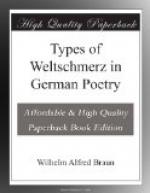Der dunkle Wald umrauscht
den Wiesengrund,
Gar duester liegt der graue
Berg dahinter,
Das duerre Laub, der Windhauch
gibt es kund,
Geschritten kommt allmaehlig
schon der Winter.
Die Sonne ging, umhuellt von
Wolken dicht,
Unfreundlich, ohne Scheideblick
von hinnen,
Und die Natur verstummt, im
Daemmerlicht
Schwermuetig ihrem Tode nachzusinnen.[159]
The sunset is represented as a dying of the sun, the leaves fall sobbing from the trees, the clouds are dissolved in tears, the wind is described as a murderer. We see then that Lenau’s treatment of nature is essentially different from Hoelderlin’s. The latter explains man through nature; Lenau explains nature through man. Hoelderlin describes love as a heavenly plant,[160] youth as the springtime of the heart,[161] tears as the dew of love;[162] Lenau, on the other hand, characterizes rain as the tears of heaven, for him the woods are glad,[163] the brooklet weeps,[164] the air is idle, the buds and blossoms listen,[165] the forest in its autumn foliage is “herbstlich geroetet, so wie ein Kranker, der sich neigt zum Sterben, wenn fluechtig noch sich seine Wangen faerben."[166] A remarkable simile, and at the same time characteristic for Lenau in its morbidness is the following:
Wie auf dem Lager sich der
Seelenkranke,
Wirft sich der Strauch im
Winde hin und her.[167]
Hoelderlin speaks of a friend’s bereavement as “ein schwarzer Sturm";[168] when he had grieved Diotima he compares himself to the cloud passing over the serene face of the moon;[169] gloomy thoughts he designates by the common metaphor “der Schatten eines Woelkchens auf der Stirne."[170] Lenau turns the comparison and says:
Am Himmelsantlitz wandelt
ein Gedanke,
Die duestre Wolke dort, so
bang, so schwer.[171]
Where Hoelderlin finds delight in the incorporeal elements of nature, such as light, ether, and ascribes personal qualities and functions to them, Lenau on the contrary always chooses the tangible things and invests them with such mental and moral attributes as are in harmony with his gloomy state of mind. Consequently Lenau’s Weltschmerz never remains abstract; indeed, the almost endless variety of concrete pictures in which he gives it expression is nothing short of remarkable, not only in the sympathetic nature-setting which he gives to his lamentations, but also in the striking metaphors which he employs. Of the former, probably no better illustration could be found in all Lenau’s poems than his well-known “Schilflieder"[172] and his numerous songs to Autumn. One or two examples of his incomparable use of nature-metaphors in the expression of his Weltschmerz will suffice:
Hab’ ich
gleich, als ich so sacht
Durch die Stoppeln
hingeschritten,
Aller Sensen auch
gedacht,
Die ins Leben
mir geschnitten.[173]
Auch mir ist Herbst,
und leiser
Trag’ ich
den Berg hinab
Mein Buendel duerre
Reiser
Die mir das Leben
gab.[174]




